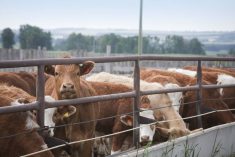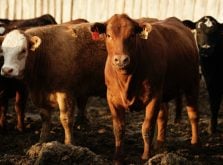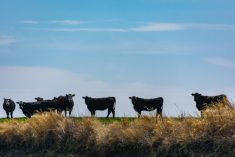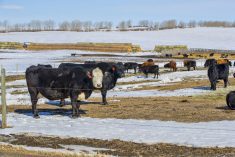This is the third article in the ‘Understanding risk for feeder cattle’ series. I started by explaining the feeder cattle futures market and basic theory of hedging. The second column focused on average basis levels and using these basis levels to forecast an expected selling price.
I analyzed the risk and reward of backgrounding 550-pound steer calves and selling 850-pound steers over the past 10 years. That program had an average return of $24 per head with a standard deviation of $158/head. If a backgrounding operation bought 550 calves and sold 850 steers every month, one could expect to make or lose $134 or $182 per head approximately 68 per cent of the time. The other 32 per cent of the time, the gains or losses were more extreme.
Read Also

Harvest wraps up and fall work begins
At the Eppich famly ranch in western Saskatchewan, the fall harvest was successful with few breakdowns, cows and calves have been sorted and a new tractor has arrived
Finally, in the previous article, I said if the operation hedged production on every round of feeding, the average return marginally improved and the standard deviation dropped by $10/head. I also described three behavioural characteristics of the cash and futures markets.
The final point
This brings us to the final article in the series. I don’t pretend this is the holy grail of risk management, but it will definitely help improve the rewards and lower the risk in the long run.
To start, I want to focus on the average and standard deviation of the basis.
Over the 10 years from Jan. 1, 2007 to Dec. 31, 2016, the average basis and standard deviation was as follows using monthly data for Manitoba.
Notice that the standard deviation for 550-pound steers is nearly twice that of 850-pound steers. Producers are buying in a high-risk basis market and selling in a significantly lower-risk basis environment. I also want to emphasize the purchase price is within the control of the producer. When selling cattle, the producer is basically a price taker but the producer can control the bids they give to the order buyer. Buying your feeder cattle at the right price and the right basis is the most important aspect of risk management.
Consider the following example. In this case study, the feeder cattle futures are currently priced at Cdn$182 while 550-pound steers are trading for $220. If we use a cost-per-pound gain of $0.80/pound, we can say that the cost of the feeder is $1,210 plus the cost to put on 300 pounds of $240, which equates to a total cost of $1,450. Under the 850-pound steer column, I’ve shown the total sale of $1,453 (850 pounds times $171/pound equals $1,453).
Remember, the basis equals the futures price minus the cash price. In the case study, the basis is -$38, which means the basis is above the futures price. ($182 minus $220 equals -$38). If the basis purchase is at -$38, the basis sale needs to be $11. In essence, the producer is becoming a basis trader.
Since the standard deviation is wider on the 550-pound calves, the key is to make the purchase at the right basis levels. The producer needs to calculate the current basis of 850-pound feeders. Then calculate back into the 550-pound calf price and basis that is needed to be profitable. Once the purchase basis comes in line so that you can buy the feeders and be profitable, the producer buys the feeders and places the hedge on the futures.
We can take this one step further. Since we know the standard deviation on the selling price is $10, the producer can add this on the current basis of the 850-pound steers and this will further enhance the profitability. If the current basis on 850-pound steers is $11, then use a basis of $21 in the calculation to back into the purchase price needed to be profitable on the 550-pound calves.
This may sound a bit convoluted at first but producers should just pencil it out or use a simple spreadsheet. In time it will become second nature. If you can’t buy the feeders at the right basis level to be profitable, then don’t buy the feeders. Be patient and the market will eventually provide an opportunity.
In the previous issue I provided three behavioural characteristics of the cash and futures markets so that producers are aware of the market dynamics in relation their current analysis. My dad always said that cattle feeding is not for the “lazy mind” and the market easily weeds out the non-thinkers.

















